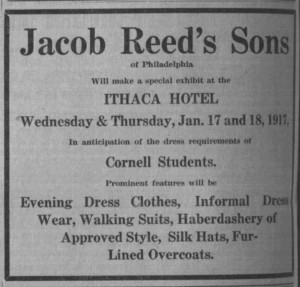Blog post by Catherine Blumenkamp, MPS ’15
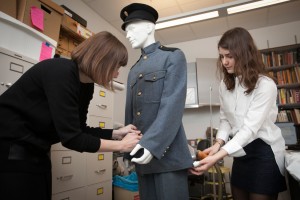
Catherine Blumenkamp and Daniela Cueva dress a mannequin with the Cornell Cadet Corps uniform in preparation for the exhibit, 150 Years of Cornell Student Fashion. Photo by Jason Koski, Cornell University Photography.
Displayed in the office of Major Trey Birdwell, Assistant Professor of Military Science, is a fifteen page letter from Cornell President A.D. White to John H. Barr, written in 1916. In the letter, President White speaks to the importance of leadership and patriotism, writing “My hope is that Cornell University, having during the first fifty years of its career, carried on such courses with admirable results, will stand firm in promoting them, and in endeavoring to have our strength brought to bear upon the world at large in new guarantees for freedom and peace.” Under the Morrill Land Grant Act and inspired by his own service during the Civil War, President White established that all male students entering Cornell be required to complete at least two years of training in military tactics.
Cornell’s first military trainees were part of the Cornell Cadet Corps and then the Student Army Training Corps, entities that preceded the Reserve Officers’ Training Corps (ROTC) established in 1916. Cornell’s cadets were required to report to duty wearing uniforms solely made by Jacob Reed’s Sons of Philadelphia. Jacob Reed’s Sons had a strong presence on campus, not limited to providing military uniforms. The merchant regularly advertised in The Cornell Daily Sun, sold their wares exclusively at The University Haberdashery, 320 College Avenue, and exhibited “special features in men’s furnishings,” from neckwear and hatbands to summer suits and sport coats, at the Ithaca Hotel (The Cornell Daily Sun, Vol. XLII, No. 45, 11 November 1921). Regulation uniforms could be purchased directly from the campus Commandant or second hand but only those that had been purchased new the previous fall. Freshman reporting to duty were cautioned “to take special care in buying second-hand uniforms as the purchase of the wrong kind will cause them a considerable loss” (The Cornell Daily Sun, Vol. XII, No. 7, 2 October 1911).
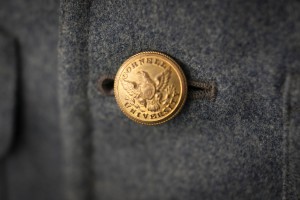
Cornell University button on Monahan’s cadet uniform. CCTC #2007.27.03. Photo by Jason Koski, Cornell University Photography
The uniform of Edward Monahan, Jr., C.U. Class of 1918, was displayed as part of the “150 Years of Cornell Student Fashion” exhibit (January 21 – July 1, 2015). The ensemble includes a coordinating pair of pants and a jacket out of heavy weight blue-grey wool and a frontside closure of brass buttons embossed with the Cornell insignia. Each piece includes the requisite Jacob Reed’s Sons label. The hat is dark blue-black wool lined in satin with a brass pin above the braided band with the letters “C” and “U” intertwined. The satin lining is stamped with the Jacob Reed’s Sons logo and “Cornell 1912.” Given Monahan was enrolled at Cornell from 1914 to 1918, the hat was likely purchased second-hand, with care.
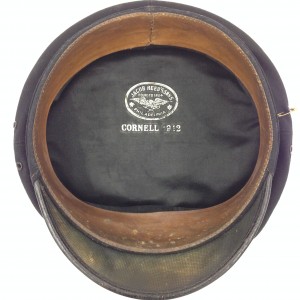
Cornell Cadet Corps uniform cap, worn by Edward Monahan, Jr. (CU 1918) during his freshman and sophomore years. CCTC #2007.27.01. Photo by Catherine Blumenkamp.
The complete uniform was donated to the Cornell Costume and Textile Collection by Monahan Jr.’s son, Dr. Edward C. Monahan, C.U. Class of 1958. In an interview, Dr. Monahan confirmed that he, too, was required to take military training as a freshman and sophomore. In 1960, Cornell’s military training became voluntary and is to this day. Today, the Army ROTC program cannot purchase anything from a “sole source” but must follow strict guidelines set forth by the Federal Acquisition Regulation, a stark contrast to the days when Jacob Reed’s Sons was the only acceptable source for uniforms.
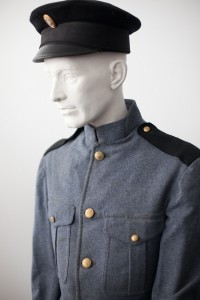
Edward Monahan, Jr.’s Cornell Cadet uniform. CCTC# 2007.27.01 – .02. Photo by Jason Koski, Cornell University Photography
Catherine K. Blumenkamp has a BA in Anthropology and received a Master’s of Professional Studies in Human Ecology (Apparel Design) in 2015. Her main areas of interest are material culture and technical design, including couture construction techniques and creative pattern cutting. Ms. Blumenkamp maintains a design practice and teaches in the fashion program at Sam Houston State University.

